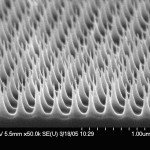 Giacomo, from the Getty Research Center, was here today to speak to us about art preservation. Having a long time career in this field, Giacomo was able to tell us how the technology in art preservation and atomic analysis has evolved over the years. The high tech gadgets of his trade, as with any other sort of technology, has grown tremendously smaller and more compact allowing for faster results. There are five key aspects to art preservation: composition, dating, provenance, artistic technique, and conservation. In this way, by first analyzing the picture on a physical basis (chemical composition, structure, etc.), art can be properly preserved in ideal conditions. This methodology can also reveal more about the piece than what meets the eye. A particular piece Giacomo talked about was by Rembrandt.
Giacomo, from the Getty Research Center, was here today to speak to us about art preservation. Having a long time career in this field, Giacomo was able to tell us how the technology in art preservation and atomic analysis has evolved over the years. The high tech gadgets of his trade, as with any other sort of technology, has grown tremendously smaller and more compact allowing for faster results. There are five key aspects to art preservation: composition, dating, provenance, artistic technique, and conservation. In this way, by first analyzing the picture on a physical basis (chemical composition, structure, etc.), art can be properly preserved in ideal conditions. This methodology can also reveal more about the piece than what meets the eye. A particular piece Giacomo talked about was by Rembrandt.  Analysis of this painting exposed more than its chemical composition. Tests revealed that Rembrandt had actually painted over a preexisting portrait that is otherwise invisible to the naked eye resulting in the painting that is visible today.
Analysis of this painting exposed more than its chemical composition. Tests revealed that Rembrandt had actually painted over a preexisting portrait that is otherwise invisible to the naked eye resulting in the painting that is visible today.
 Lab visits included a hands-on demo of the electron microscope and super hydrophobic surfaces. The electron microscope was extremely compact. We looked at tissues under super high resolution and magnification. Having the opportunity to personally use the microscope gave me an entirely different perspective on microscopy. I’m so used to just seeing high magnification pictures in textbooks that it really is a breath of fresh air to be able to tangibly hold a sample and then see that very sample under magnification. It was an experience to remember. The demonstration of super hydrophobic surfaces reminded me of the cells lipid bilayer. The engineered surface’s amphipathic nature having both hydrophobic and hydrophillic regions simply borrows from what nature has already created. This concept of engineering (basing nano structures on naturally occurring molecules) was explained in Softmachines.
Lab visits included a hands-on demo of the electron microscope and super hydrophobic surfaces. The electron microscope was extremely compact. We looked at tissues under super high resolution and magnification. Having the opportunity to personally use the microscope gave me an entirely different perspective on microscopy. I’m so used to just seeing high magnification pictures in textbooks that it really is a breath of fresh air to be able to tangibly hold a sample and then see that very sample under magnification. It was an experience to remember. The demonstration of super hydrophobic surfaces reminded me of the cells lipid bilayer. The engineered surface’s amphipathic nature having both hydrophobic and hydrophillic regions simply borrows from what nature has already created. This concept of engineering (basing nano structures on naturally occurring molecules) was explained in Softmachines.